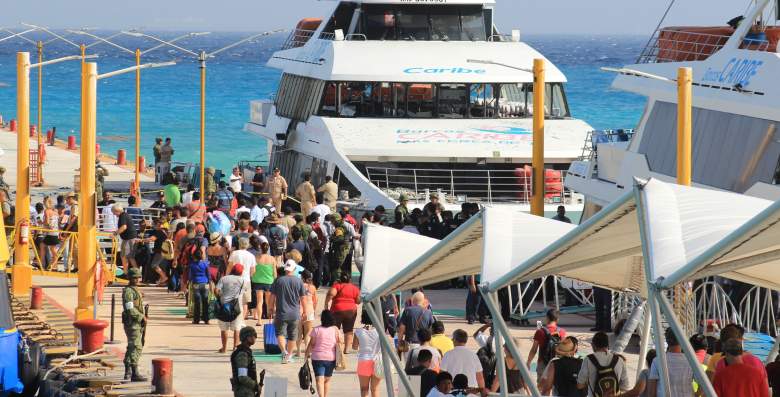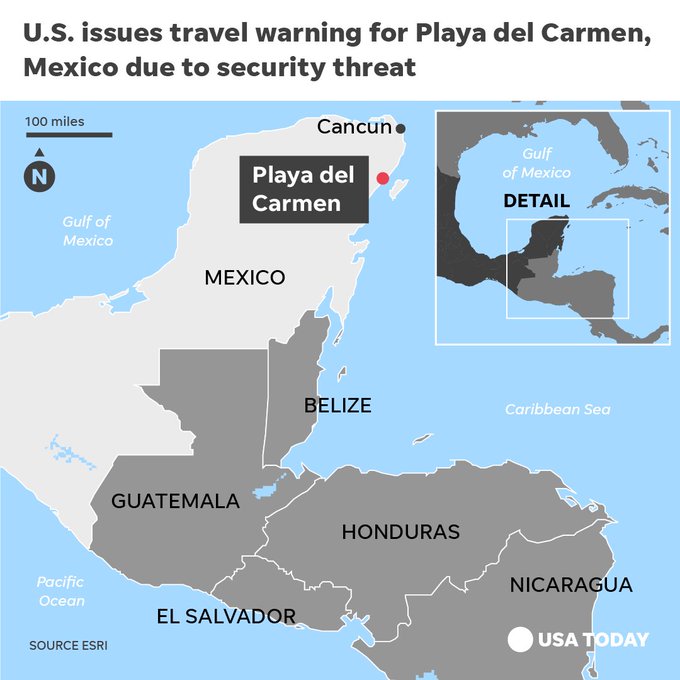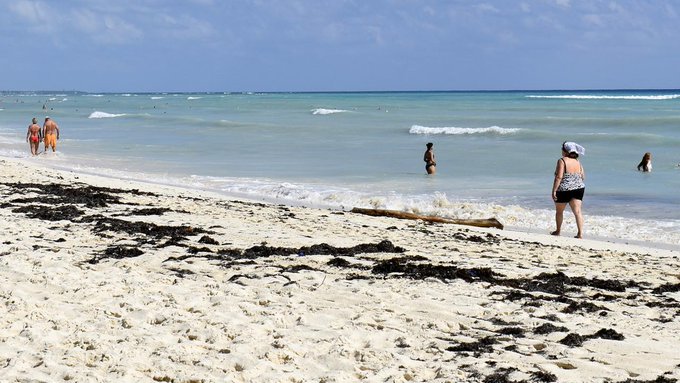
Getty Federal police officers and army soldiers arrive at the dock where an explosion occurred on a ferry in Playa del Carmen, Quintana Roo state, Mexico on February 21, 2018.
Playa del Carmen is a Mexican resort town popular with American and European tourists not far from Cancun. Recently, though, the town has been the subject of bad press about its safety.
How safe is Playa del Carmen? The U.S. Embassy in Mexico City issued a travel warning for the community on March 7, 2018 not long after an explosion at a popular ferry that takes tourists to Cozumel. You can see video of the ferry explosion below. It’s not clear whether the warning is linked to the ferry explosion, which happened February 21, 2018, though. Some of the all-inclusive resorts have also had issues with bootlegged liquor.
The Canadian government has also issued “a safety and security warning for travellers visiting Playa del Carmen in Mexico,” according to The Star.
Here’s what you need to know:
1. The U.S. Consular Agency in Playa del Carmen Was Closed After a Threat

GettyView of the US consular agency in Playa del Carmen, Quintana Roo state, Mexico, on March 8, 2018, after it was closed indefinitely due to a security threat.
Although the nature of the threat was not revealed, the U.S. Embassy in Mexico City revealed that one was received. “On March 7, the U.S. Embassy in Mexico City received information about a security threat in Playa del Carmen, Quintana Roo, Mexico,” the embassy wrote in a travel warning on its website.
“Effective immediately, U.S. Government employees are prohibited from traveling to Playa del Carmen until further notice. The U.S. Consular Agency in Playa del Carmen will be closed until further notice.”
The embassy advised that travelers stay “aware of your surroundings and exercise caution. Purchase travel insurance that specifically covers you in Mexico and includes medical evacuation insurance. Contact the nearest U.S. Embassy or Consulate if you need assistance.”
On March 9, the embassy revised its travel restriction. “Due to an ongoing security threat, the U.S. Embassy in Mexico City is revising its travel restrictions to Playa del Carmen for U.S. government personnel,” the advisory reads. “U.S. government personnel are prohibited from travel to Centro, Calica, Gonzalo Guerrero, Quintas del Carmen, and Villas del Carmen neighborhoods of Playa del Carmen. These neighborhoods are bordered by Avenida Benito Juarez, 50 Avenida Sur (Highway 307), and Calle 34 Norte.”
The American government is also advising that “U.S. citizens should avoid those neighborhoods until further notice. U.S. government personnel are authorized to travel to resort areas in Riviera Maya including those near Playa del Carmen that are outside the restricted neighborhoods of this Alert Absent additional changes in the security situation, the U.S. Consular Agency in Playa del Carmen will reopen for normal operations on Monday, March 12.”
The embassy added, “The circumstances surrounding the security threat affecting the above neighborhoods is separate from the threat against ferries operating between Playa del Carmen and Cozumel. U.S. government personnel are still prohibited from using ferry services between Playa del Carmen and Cozumel until further notice. U.S. citizens should not use ferry services operating between Playa del Carmen and Cozumel.”
2. An Explosion Rocked a Popular Tourist Ferry & Pirates Attacked a Ferry Years Ago
Twenty-six people were injured in a February 2018 explosion on a tourist ferry that shuttles people from Playa del Carmen to Cozumel.
The explosion occurred as the ferry was unloading passengers in Playa. Seven Americans and three Canadians were among the injured. No one was killed in the blast.
An explosive device caused the blast. A drug gang took credit for the explosion, Reuters reported, adding that the ferry line is “owned by the father of former Quintana Roo state Governor Roberto Borge, who is facing corruption charges.”
On March 6, 2018, more explosives were found. “…undetonated explosives were found on a ferry that runs between the Caribbean resorts of Playa del Carmen and the island of Cozumel,” CBS News reported.
“…the boat was anchored 500 yards (meters) from the Cozumel dock and was not in service when the object was discovered Thursday… a company diver reported the object, and Mexican navy divers removed it,” CBS reported.
As a result of the ferry explosion, several cruise lines “including Carnival, Royal Caribbean and Disney, canceled all shore excursions involving ferries between Cozumel and Playa del Carmen,” according to AL.com.
In 1999, pirates attacked a ferry that ran between Cozumel and Playa del Carmen. “Brandishing a grenade and firing assault rifles into the night air, half a dozen hooded pirates attacked a ferry returning from the Caribbean resort isle of Cozumel,” The Los Angeles Times reported. “They robbed passengers of money and valuables, threw two security guards overboard and beat a crew member Monday night before speeding off in another boat.”
3. The State Department Urged Travelers to Show ‘Extra Caution’ in Mexico Because of Crime

Federal police officers and army soldiers arrive at the dock where an explosion occurred on a ferry in Playa del Carmen, Quintana Roo state, Mexico on February 21, 2018.
It’s not just Playa del Carmen. The U.S. State Department issued another travel warning for the country of Mexico on January 10, 2018. “Exercise increased caution in Mexico due to crime. Some areas have increased risk,” the travel warning says. “Violent crime, such as homicide, kidnapping, carjacking, and robbery, is widespread.”
The State Department also warned: “The U.S. government has limited ability to provide emergency services to U.S. citizens in many areas of Mexico as U.S. government employees are prohibited from travel to these areas.” The State Department advises that Americans not travel to these areas of Mexico:
Colima state due to crime.
Guerrero state due to crime.
Michoacán state due to crime.
Sinaloa state due to crime.
Tamaulipas state due to crime.
The situation is dangerous enough that U.S. government employees have travel restrictions in Mexico. “U.S. government employees are prohibited from intercity travel after dark in many areas of Mexico,” the State Department reports. “U.S. government employees are also not permitted to drive from the U.S.-Mexico border to or from the interior parts of Mexico with the exception of daytime travel on Highway 15 between Nogales and Hermosillo.”
Five people were shot and killed in Playa del Carmen at the Blue Parrot Nightclub in January 2017.
4. Previous Warnings Discussed Tainted Alcohol
It’s not only the crime and explosions that worry some travelers. The U.S. State Department urged vacationers to avoid excessive consumption of alcohol, saying, “There have been allegations that consumption of tainted or substandard alcohol has resulted in illness or blacking out. If you choose to drink alcohol, it is important to do so in moderation and to stop and seek medical attention if you begin to feel ill.”
The Mexican tourism secretary told CNN that “the region receives 11 million tourists a year at more than 98,000 hotel rooms, and adheres to strict quality measures.” However, The Milwaukee Journal Sentinel published an investigative series that alleged that tourists were reporting blackouts at all-inclusive resorts in the area, and Mexico has now been seizing illegal tequila and shutting down distributors who make it.
Abbey Conner, a 20-year-old tourist from Wisconsin, died after one such black out. You can read more of the Wisconsin newspaper’s reporting here.
5. Mexican Officials Have Pushed Back on Claims the City Is Not Safe
Mexican officials, who clearly want to protect the tourist trade that is so important to Quintana Roo, used a visit to Playa del Carmen by President Enrique Pena Nieto to argue the area is safe to visit.
In addition to being a popular diving destination, the Mexican town on the Caribbean has white sand beaches, all-inclusive resorts, and turquoise waters that draw tourists who also like its location not far from popular destinations like Tulum. It doesn’t have quite the party atmosphere as Cancun, either, drawing more families and older vacationers.


